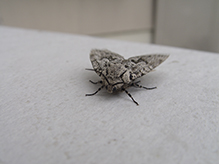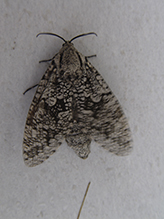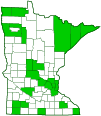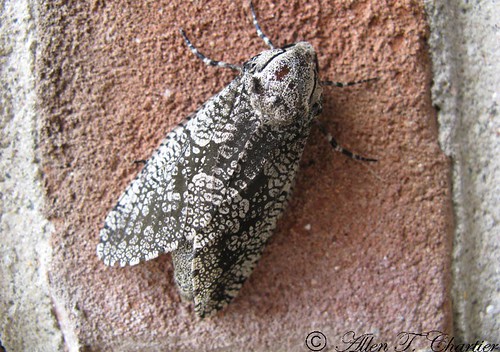carpenterworm moth
(Prionoxystus robiniae)
Conservation • Description • Habitat • Ecology • Distribution • Taxonomy
|
||||||||
| Hodges # | 2693 |
|||||||
Conservation Status |
||||||||
| IUCN Red List | not listed |
|||||||
| NatureServe | NNR - Unranked |
|||||||
| Minnesota | not listed |
|||||||
Description |
||
Carpenterworm moth, also called Robin’s carpenterworm, is a medium-sized moth but a very large micromoth. It is similar in size and appearance to a sphinx moth and is often misidentified as one. Adults are 1 1 ⁄16″ to 1¾″ long with a wingspan of 1 7 ⁄16″ to 3⅜″. The female is much larger than the male. The body is heavy. The abdomen extends well beyond the hindwings. The forewings on the female are more or less triangular and rounded at the tip. They are pale gray and semi-translucent with a dense, net-like overlay of thin, dark lines and, in the basal and median areas, wider lines that fill in the blank areas creating dark blotches. They have an accessory cell and 2 anal veins that are complete, extending from the base to the margin. Some of the veins branching off of the “R” vein are stalked. The forewings of the male are similar but narrower and more pointed at the tip. The hindwings of the female are as wide as the forewings but much shorter. They are similar in color to the forewings but with a less distinct overlay of thin lines and no wider lines. They have 3 anal veins. The hindwings of the male are similar in shape, black from the base to the median area, bright yellowish-orange from the median area to the submarginal area, and bordered with a thin black marginal line. The hindwings and forewings are held in contact by bristles (a frenulum) and scales (a retinaculum). The head is gray. There are no mouth parts and no hearing organs. The antennae on the male are feathery, with extensions along both sides of the central axis (bipectinate). On the female the antennae are thread-like. The legs are black with white bands. There is a large spine (spur) at the tip of the fourth leg segment (tibia). The caterpillar is 2″ to 2¾″ long. It may be greenish-white with a dark brown head and thoracic shield, or pinkish with scattered dark spots and a reddish-brown head and thoracic shield. |
||
Size |
||
Wingspan: 1 7 ⁄16″ to 3⅜″ Total length: 1 1 ⁄16″ to 1¾″ |
||
Similar Species |
||
Habitat |
||
Deciduous and mixed forests, hardwood shelterbelts. |
||
Ecology |
||
Season |
||
May through July |
||
Behavior |
||
Adults are attracted to light. |
||
Life Cycle |
||
The female lays eggs singly or in groups in the crevices of the bark of a host tree. After hatching, the caterpillars feed by boring into the cambium layer of the tree. This creates galleries and tunnels under the outer bark that decrease the value of the wood and can sometimes kill the tree. Wood has little nutritional value. As a result, the caterpillar takes 3 or 4 years to complete its life cycle. It pupates in the spring of its final year and emerges as an adult between May and July. |
||
Larva Hosts |
||
Ash, black locust, oak, poplar, and willow |
||
Adult Food |
||
Adults do not feed |
||
Distribution |
||||
|
Sources |
|||
| 5/30/2023 | ||||
Occurrence |
||||
Widespread but uncommon |
||||
Taxonomy |
|||
Order |
Lepidoptera (Butterflies and Moths) | ||
Superfamily |
Cossoidea (carpenter, leopard, goat, and allied moths) | ||
Family |
Cossidae (carpenter and leopard moths) | ||
Subfamily |
Cossinae | ||
Genus |
Prionoxystus | ||
Synonyms |
|||
|
|||
Common Names |
|||
carpenterworm Larva) carpenterworm moth (adult) locust borer Robin’s carpenterworm |
|||
Glossary
frenulum
A spine (male) or multiple spines (female) at the base of the costal edge of the hindwing of many moths that couples with the retinaculum on the forewing to keep the wings in contact which each other.
Tibia
The fourth segment of an insect leg, after the femur and before the tarsus (foot).
Visitor Photos |
|||||
Share your photo of this insect. |
|||||
| This button not working for you? Simply email us at info@MinnesotaSeasons.com. Attach one or more photos and, if you like, a caption. |
|||||
Jennifer Ayala |
|||||
flew in our door and i hit it under some paper towels a few times but it did not die! i picked up the paper towel and it was still alive amd i threw it outside very big and it had something that looked like a tongue coming out the back end like a finger and was buzzing strong before it took off like a plane it was huge! |
 |
||||
Bill Reynolds |
|||||
 |
 |
||||
MinnesotaSeasons.com Photos |
|||||
|
|||||

Visitor Videos |
|||
Share your video of this insect. |
|||
| This button not working for you? Simply email us at info@MinnesotaSeasons.com. Attach a video, a YouTube link, or a cloud storage link. |
|||
Bill Reynolds |
|||
| Robin's carpenterworm (Prionoxystus robiniae) Dec 18, 2015 |
|||
About
The first two images, if you notice, the wings are blurred and the back end. It is vibrating it's muscle and getting ready for take off. The video is the … moth revving up. Location: Pennington Co., MN video by Bill Reynolds http://minnesotaseasons.com/Insects/Robins_carpenterworm.html |
|||
Other Videos |
|||
| Carpenterworm Moth (Cossidae: Prionoxystus robiniae) on Wall Carl Barrentine |
|||
About
Uploaded on Jun 21, 2011 Photographed at Fisher, Minnesota (21 June 2011). Thank you to Maury Heiman (@Bugguide.net) for confirming the identity of this specimen! |
|||
| You're Just Too Good To Be True...Can't Take My Eyes Off You... Carl Barrentine |
|||
About
Uploaded on Jun 24, 2011 A Crab Spider (Xysticus) sizes up a Carpenterworm Moth (Prionoxystus). ;-) Photographed at Grand Forks, North Dakota (24 June 2011). |
|||
| Robin's Carpenterworm Moth (Cossidae: Perionoxystus robiniae) Lateral view Carl Barrentine |
|||
About
Published on Jun 2, 2012 Photographed at Grand Forks, North Dakota (02 June 2012). |
|||
| Carpenter Moth (Cossidae: Prionoxstus) Carl Barrentine |
|||
About
Uploaded on Jun 7, 2010 Photographed at Grand Forks, North Dakota (06 June 2010). |
|||


Created 12/18/2015
Last Updated:




